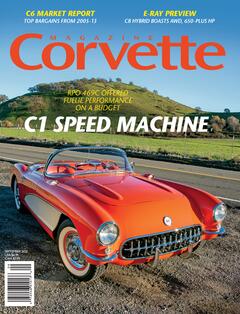Every Corvette belongs in a good home, especially a classic one worthy of preservation. But what does it take to keep such a car running and looking nearly new? Just ask Kevin Ferguson, who has worked for 36 years as a master mechanic and in that time built and customized more than 70—yes, 70—cars. All of them had one thing in common.
“I go to bed with a bowtie on,” he admits, referring, of course, to the Chevrolet engines they all have (even the non-GM marques). So he could hardly turn away from a collection of Corvettes he came across quite by accident.
“I went to look at a dog for adoption, and the owner asked me if I liked ‘toys,’” Ferguson relates. The gentleman then proceeded to open up a 20-car garage with more than a dozen Corvettes and hot rods, plus a solid wall of shop manuals. After Ferguson identified every one of the cars, a hidden gem revealed itself.

“I saw part of the grille and asked, ‘Is that a ’57?’ I had to look further and asked if it was for sale. Well, obviously it was, because I am now the third owner. He’d had the car for 23 years.”
The men cut a deal for $100,000, which included a ’59 El Camino in the price. Unlike the familiar stories about classic-Corvette acquisitions, this C1 was not a basket case, but rather in relatively good cosmetic condition considering its age. Even so, Ferguson had his work cut out for him.
The 283-ci, 270-hp 469C engine, with its mechanical lifters and dual Rochester carbs, was sputtering and spitting. The leather in the accelerator pump had dried out, and the distributor was the original factory unit. The shocks were so bad that the driveshaft slapped against the underbody. “I had to heel-and-toe it to get it home, [and] barely made it,” Ferguson recalls. “It took an hour to go 36 miles, stalling out a lot.”

He spent the next six months or so rebuilding the worn-out carburetors, flushing out all the fluids, replacing the filters, doing a complete tune-up, and replacing the exhaust “donut” gaskets. Also, while rebuilding the wheel cylinders for the brakes, he discovered that the brake fluid had transformed into something resembling black tar.
As for those mushy shocks, Ferguson replaced the original Delcos with Bilsteins. He also found out that the previous owner had taken the body off at some point to install new mounts, but subsequently gave up on the project. Closer inspection revealed that the frame stamp on this ’57 had an 11th-month ’56 production number. The car came with a three-speed gearbox from the factory, but in 1960 the transmission was replaced with a T10 four-speed unit. Since such an upgrade was common for the era, and because it improved the car’s drivability considerably, Ferguson elected to leave it in place.
Some of the car’s cosmetics needed attention as well. In addition to a general scrubbing, Ferguson polished all the chrome and trim pieces. The car came with both soft and hard tops, and the latter needed buffing out involving a lot of elbow grease. And the original Venetian Red body color had been repainted by the previous owner, but not in lacquer. So Ferguson massaged the finish with a Griot polisher to bring out the vivid hue. Finally, he took out the cables for tach and speedo and replaced them. “Everything works nice now,” he reports. “It purrs like a kitten.”

He drives the car weekly to keep things lubricated, but no further modifications are planned, as he wants to keep it as close to original as possible. But while he exercises the car regularly, he doesn’t drive the ’57 on long trips. “I won’t take it anywhere that it leaves my sight,” Ferguson insists. “It’s too easy to hot-wire.”
And besides, there are comfort and usability issues to consider. “Let’s face it, this car wasn’t built for big boys,” he points out. “I’m 230 pounds and five-ten, and I have to squeeze my body into the car. [And] handling is not its best attribute.”
That’s especially true compared with his 2016 C7 with the LT2 package and Magnetic Ride suspension: “I love that car,” Ferguson enthuses. “It handles like a dream. The ’57 is loose on the road in comparison. Let’s face it: A suspension with kingpins, tie rods, idler arm, and Pitman arm is no match for modern technology.”

Yet owning and driving a ’57 Corvette brings more smiles and thumbs-up as he’s driving. “Kids, moms, and dads all seem to love it. How cool is it to own one of only 6,339 1957 Corvettes ever built?”
While Ferguson’s Corvette has won awards, there’s more to his ownership and enjoyment of the car. He belongs to the Americana Corvette club, a nonprofit outfit that raises money for various organizations. Many of its members, ranging in age from their 30s to 80s, own multiple Corvettes themselves.
But while every member enjoys owning and driving his or her own example of America’s Sports Car, “Nothing is finer than a ’57,” Ferguson feels. “It has a grille like it’s going to take a bite out of you. And it’s a sexy car, with the two-tone color scheme and cream coves. It is and will remain an icon forever.”
All the better that it’s being looked after by a dedicated torchbearer.





